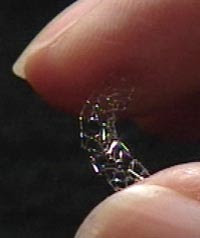Fischman DL, Leon MB, Baim DS, et al. New England Journal of Medine. “A Randomized Comparison of Coronary-Stent Placement and Balloon Angioplasty in the Treatment of Coronary Artery Disease”. 1994; 331:496-501
http://nejm.highwire.org/cgi/content/full/331/8/496
This 1994 clinical study compares the effectiveness of old, standard balloon angioplasty(BA) versus a new method of implanting metal, balloon-expandable stents. Most studies preceding this test focused on simple balloon angioplasty with the major limitations being acute collapse of the vessel (acute closure) or later scar formation or restenosis, as nnoted above. Attempting to deal with these critical issues, other techniques where developed including atherectomy, or removal of plaque from the arteries, as a method of preventing restenosis. However atherectomy proved ineffective, and this article explores stents as an alternate way to reduce restenosis. The results of this test showed that the new technique reduced not only the incidence of restenosis after the procedure, but also the need for patients to undergo addition revascularizations. The study informs its readers that while the stents are more effective at preserving the width of the artery, and preventing restenosis than standard balloon angioplasty, there are certainly some limitations associated with this new therapy. These metal stents are not all-powerful, they do not reduce the rate of future coronary events any more than a normal balloon angioplasty. On a similar note, implanted stents can induce thrombosis. For this reason, it becomes necessary for the patient to go on antiplatelet agents. Potent anticoagulants can result in further peripheral vascular problems and critical issues with bleeding. Although this new therapy unquestionably reduces the need for the patient to receive multiple balloon angioplasties, it could increase mortality due to stent thrombosis. This article was probably read mostly by physicians, given that it appeared in the New England Journal of Medicine, and it was reported in the lay press as it was interest to the general public as well. The medical world, including health organizations and sectors of the government, most likely had mixed views about this test. It presented the biomedical community with a new, effective alternative, but not without health risks which would need to be addressed as separate problems. Similarly, the public probably anticipated the new coronary-stent technique with both hope and anxiety. The federal government and insurers were certainly torn between the desire for a treatment that reduced the need for follow-up angioplasties, but resulted in large increase in cost related to the new stents. Stents are still widely used, but people with the stents have to take drugs to prevent thrombosis, or blood clots. The following post addresses the efficiency of several antithrombotic drugs to help improve the lives of patients with stents.


No comments:
Post a Comment